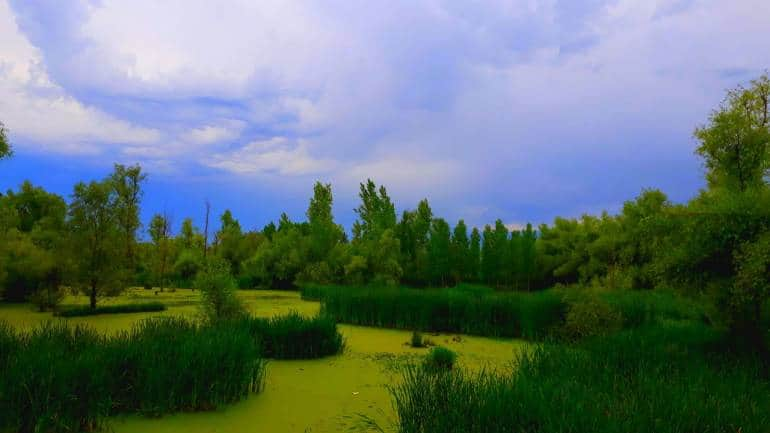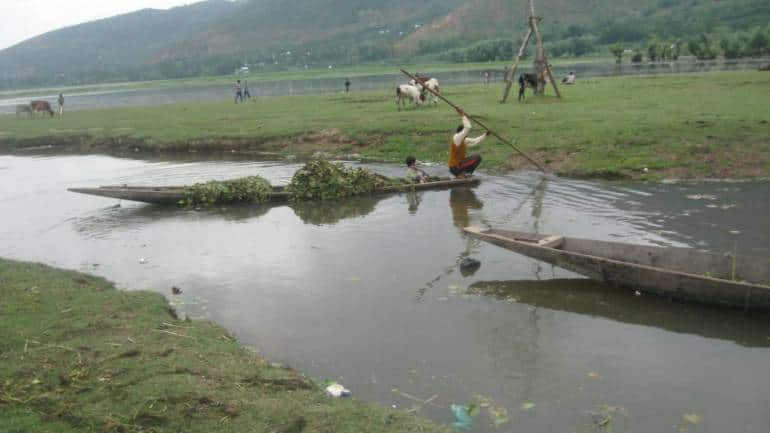



The wetland ecosystems of Kashmir mostly includes Dal Lake, Anchar, Wular, Haigam, Shallabugh, Narkara and Hokersar. However, according to an environmentalist at the University of Kashmir, most of these waterbodies, referred to as nature's kidneys, have shrunk in size in the last five decades and are on the brink of extinction. “Fifty years ago, people in Srinagar could find a pond around their surroundings. But not anymore," he said.
A recent Government of India (GoI) report revealed that between 2006 and 2018, Jammu & Kashmir lost more than 2372 kanal of wetlands. “Over 120 hectares (2373 kanal) of wetland were lost in J&K between 2006-07 and 2017-18,” reads the report of the Ministry of Statistics and Programme Implementation (MOSPI), a department of the GoI concerned with the coverage and quality of statistics.
The ‘queen wetland of Kashmir’ Hokersar, or Hokera, overlooked by Pir Panjal hills, located 12 kilometres west of Srinagar city, has lost 5.75 sq km of area in the last four decades. Hokersar was designated as a wetland of international importance under the Ramsar Convention on November 8th 2005.
 The ‘queen wetland of Kashmir’ Hokersar, or Hokera, has lost 5.75 sq km of area in the last four decades. (Image: Rayeesmaqboolkashmir/Wikipedia)
The ‘queen wetland of Kashmir’ Hokersar, or Hokera, has lost 5.75 sq km of area in the last four decades. (Image: Rayeesmaqboolkashmir/Wikipedia)
Similarly, an analysis of land cover data from 2016 reveals that the catchment of Narkara wetland is now predominantly an urban setting with built-up areas covering 37.12 percent of the total catchment area. “The pace of urbanisation has been more pronounced after 1980,” a study by researchers from the University of Kashmir reveals.
Wular Lake, the second-largest fresh-water lake in Asia, situated on the foothills of Haramuk Mountain, is the largest natural floodwater storage in the Jhelum basin. It has significantly shrunk in the last 100 years: The open water surface has shrunk from 90 sqkm in 1911 to less than 15 sqkm in 2013.
Even the famous Dal Lake, part of a natural wetland, has shrunk significantly in the past five decades. According to a 2018 report by the Dredging Corporation of India, the famous tourist spot's size has decreased from 22 sqkm to 10 sqkm (The lake's original size was 75 sqkm around AD 1200).
The Haigam Wetland Conservation Reserve has reduced in size considerably mainly due to paddy cultivation. A team from Green Citizens Council, also called Environmental Policy Group (EPG), which made an on-the-spot assessment of Hygam Wetland, recently described it as “dead and buried".
According to environmental activist Manzoor Wangnoo, most of the wetlands are in bad condition and a lot of work has to be done by people and government to restore the pristine glory of these wetlands.
In 2017, a research by the Department of Earth Sciences, University of Kashmir, revealed that nearly 20 wetlands have vanished in urban colonies in and around Srinagar city in the last five decades. The study mentioned that the total area of major wetlands in the Jhelum basin with an area more than 25 ha has decreased from 288.96 sqkm in 1972 to 266.45 sqkm now.
Wetlands on both sides of Jhelum act as reservoirs of the floodwaters. But in the last five decades, most of the wetlands have lost their carrying capacity due to conversion into agriculture land or concrete landscape. Residential colonies in the city, which had never flooded in the past, got inundated up-to 19 feet in the past.
According to a study by the Department of Environment, Ecology and Remote Sensing (government of Jammu & Kashmir), more than 50 percent of water bodies in Srinagar and its suburbs have been lost in the past century. “The comparative change analysis of the two maps based on the year 1911 and 2000 reveal that wetlands like Batamaloo Nambal, Rakh-i-Gandakshah and Rakhi-i-Arat and Rakh-i-KhanKhan, besides streams of Doodhganga and Nala Mar, have been completely lost while other lakes and wetlands have experienced considerable shrinkage in the last century,” the study says.
The flood vulnerability scenario in the Jhelum basin has worsened in the last few decades as a significant number of the lakes and wetlands in the basin, that used to store floodwaters and act as sponge during flooding, have been urbanised and converted into concrete landscape in the entire Kashmir Valley. Most of the wetlands and water bodies in Jhelum basin are fighting a losing battle for their survival.
 Wular Lake is the second-largest fresh-water lake in Asia (Image: Maxx786 /Wikipedia)
Wular Lake is the second-largest fresh-water lake in Asia (Image: Maxx786 /Wikipedia)
"Wetlands play a vital role in carbon sequestration and act as earth's kidneys. But due to ill-planned development and urbanisation, most of these have terribly shrunk," said Javaid M Dad, a former senior research associate at department of Botany, Kashmir University. He added, “Wetlands decrease flooding, remove pollutants from water, recharge groundwater, protect shorelines, and provide habitat for wildlife. They are an important habitat for migratory water birds and are must-visit places for tourists coming to Kashmir.” Every year, between October and March, the wetlands of Kashmir valley hosts lakhs of migratory birds coming from Philippines, Siberia, China, Japan and central Asia.
Wildlife Warden Wetlands Kashmir, Ifshan Dewan told Moneycontrol that this year as many as 13 lakh migratory birds visited Kashmir compared to 12 lakhs last year.
The rootstocks of lotus plant, locally known as ‘Nadru’, and water chestnut (Trapa natans), locally known as ‘Gaer’, which grows extensively in the water bodies of Kashmir valley, provides subsistence to a lot of people.
The traditional reed mats, locally called ‘Wagoow’, made from the wild vegetation that grows on the wetlands of Kashmir valley, also provide a source of income to artisans.
Dad said that wetlands act as a sponge that retains excess water. However, the gradual squeezing of these waterbodies has affected the buffering capacity to withhold flood water and storm water runoff. For example, water-logging in Srinagar has become a menace during incessant precipitation events.
Loss of wetlands was also cited as one of the reasons that aggravated major floods in Jammu and Kashmir in September 2014, which claimed about 300 lives and inundated thousands of villages for weeks. “New housing colonies in uptown areas of Srinagar - Bemina, Tengpora, Hyderpora, Nowgam and Lasjan - sit on what used to be wetlands. These wetlands used to accommodate surplus water during floods. With these floodwater sponges gone defunct, Srinagar has become more vulnerable to floods,” Dad said.
The Bombay Natural History Society (BNHS), which has carried out several studies in the Kashmir Valley, revealed that there has been a severe loss of wetland habitat for various commercial activities. “Field studies suggest that there has been a huge loss of wetlands in the Kashmir Valley over the years. In the past 30 years, nearly 50 percent of the wetlands in the valley have been encroached upon or severely damaged," said BNHS Director Asad Rahmani. According to BNHS, Dal Lake in Srinagar has witnessed numerous reclamations all along its periphery in the marshy areas which has reduced its area to just about 1,200 hectares.
Similarly, the vast expanse of the Wular Lake in Bandipora, 60 km from Srinagar, which once covered 20,200 hectares of area, is now restricted to a mere 2,400 hectares. “The disastrous damage to life and property could have been minimised if the wetlands that once existed in the valley were preserved," Rahmani said. Environmental experts have also claimed that the open waters of the wetland have been colonised by the weeds and other aquatic vegetation.
Dr Raja Muzaffar Bhat, on whose petition the National Green Tribunal (NGT) passed orders for conservation of wetlands in Kashmir, said that although J&K Wetland Authority was formed for the protection and conservation of wetlands, it has not been proactive. “Government should first stop illegal mining in tributaries because the constant river bed mining has degraded the wetlands and then siltation is another big challenge. Dredging, de-silting and de-weeding should be actively done for restoration and rejuvenation of wetlands ,” said Bhat, founder of J&K RTI Movement.
Regarding the degradation of wetlands, Dewan said that massive restoration work is being done in Hokersar, Shallabugh and other wetlands to revive them in their original shape. “We have also retrieved 3000 kanals of wetland in Hokersar and 1800 kanals in Haigam during the anti-encroachment drives.”
Discover the latest Business News, Sensex, and Nifty updates. Obtain Personal Finance insights, tax queries, and expert opinions on Moneycontrol or download the Moneycontrol App to stay updated!
Find the best of Al News in one place, specially curated for you every weekend.
Stay on top of the latest tech trends and biggest startup news.